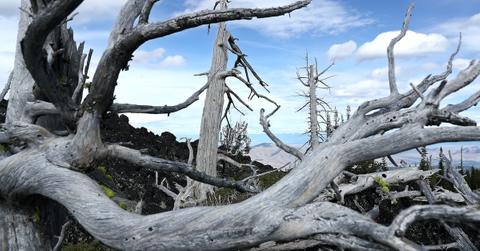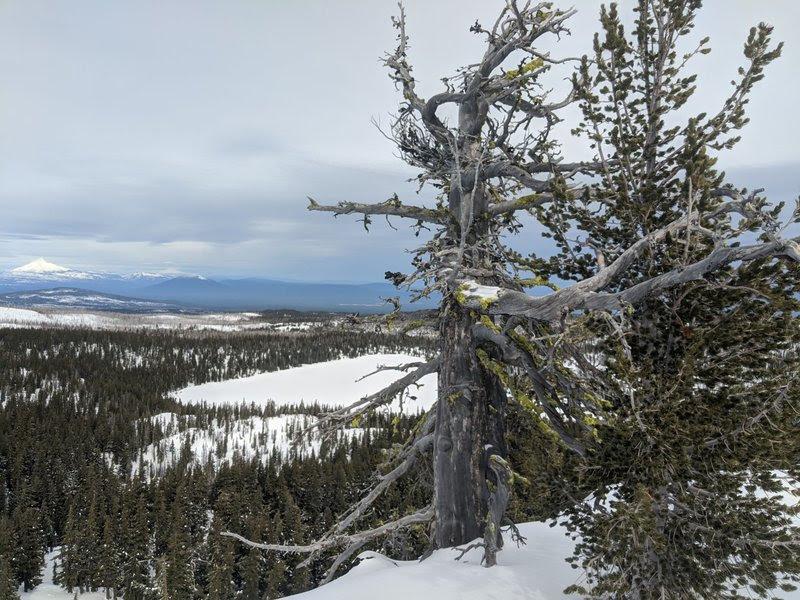Dying Whitebark Pine Trees Denied Critical Habitat Protection Due to Trump Rule
Whitebark pine trees were given protections under the Endangered Species Act — but due to a Trump administration rule, they were denied critical habitat protections.
Published Dec. 3 2020, 1:18 p.m. ET

This week, the U.S. Fish and Wildlife service proposed "threatened" species protections under the Endangered Species Act for the whitebark pine tree. Not only will this help the dwindling tree population, but it will also help animals that depend on the whitebark pine tree for food, such as the grizzly bear.
But unfortunately, due to a rule put in place by the Trump administration, the whitebark pine tree cannot get all of the protections it needs.
To learn more about the whitebark pine, how grizzly bears and other animals depend on it, and why a Trump rule is holding the tree back from gaining critical habitat protections, keep on reading.

The whitebark pine tree is essential to biodiversity in the U.S.
As the Center for Biological Diversity tells Green Matters, the whitebark pine tree is a high-elevation tree found in seven U.S. states: California, Idaho, Montana, Nevada, Oregon, Washington, and Wyoming. The tree’s seeds provide food for grizzly bears and various other animal species, and without this tree, these animals would have to look for other food, reducing their chance of survival.
Climate change is killing the whitebark pine.
There are two key factors hurting the whitebark pine, according to the Center for Biological Diversity.
While most humans are worried about COVID-19, whitebark pine trees (rather, the people who care about them) are worried about white-pine blister rust. As explained by the U.S. Forest Service, white-pine blister rust is caused by a non-native fungus called Cronartium ribicola. In all case studies of the blister rust’s effect on North American white pines, the trees unfortunately exhibited low levels of resistance and high mortality rates.
The other factor hurting whitebark pine trees is the climate crisis. That’s because the changing climate is causing the mountain pine beetle population to flourish, and mountain pine beetles kill the whitebark pine. This makes room for competing tree species to outgrow the whitebark pine, taking control of these high-elevation habitats. Oddly enough, this shift can lead to worse forest fires.
“The loss of whitebark pine and its impact on grizzlies and high-elevation forests shows how tightly knit the world is,” Noah Greenwald, endangered species director at the Center for Biological Diversity, tells Green Matters in a statement. “If we don’t address the extinction crisis by protecting more places, reducing our greenhouse gas emissions and better regulating trade in plants and animals, the natural world and our way of life will unravel before our eyes.”
The U.S. Fish and Wildlife service proposed threatened species status for the whitebark pine.
On Tuesday, Dec. 1, the U.S. Fish and Wildlife Service proposed that the federal government grant the whitebark pine “threatened” species status under the Endangered Species Act.
“Recognition of whitebark pine as a threatened species shows just how profoundly climate change and introduced diseases are changing our world,” Greenwald adds. “These beautiful and important trees need our help. I’m relieved they’re getting the strong protections of the Endangered Species Act, because it’s our best tool for stemming the tide of the extinction crisis.”
However, last year, the Trump administration set a rule dictating that “only species where habitat destruction is the primary threat will receive [critical habitat] protection.” Because of this, the whitebark pine was denied these critical habitat protections, which would significantly help protect the species, according to the Center for Biological Diversity.
As Whitebark Pine Ecosystem Foundation director Robert Mangold explained to Montana Free Press, the whitebark pine species is not one "suffering much from issues around take, we’re not logging this tree, and people aren’t harvesting it. It’s usually in very remote areas."
Considering that, it really makes no sense that the whitebark pine is not being granted critical habitat protections.
Hopefully when the Biden administration takes over in January, some more changes will be made to protect this important tree species.